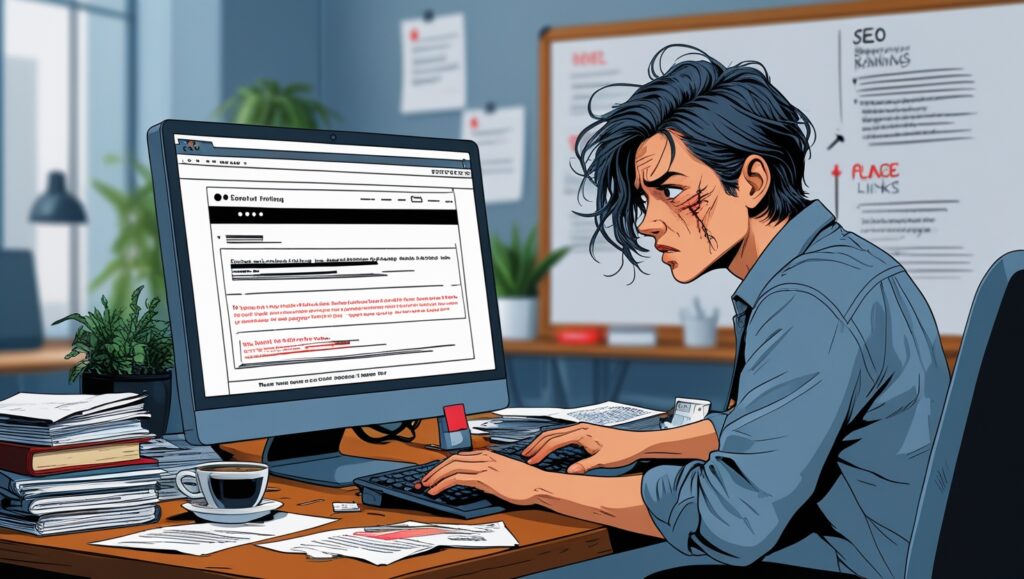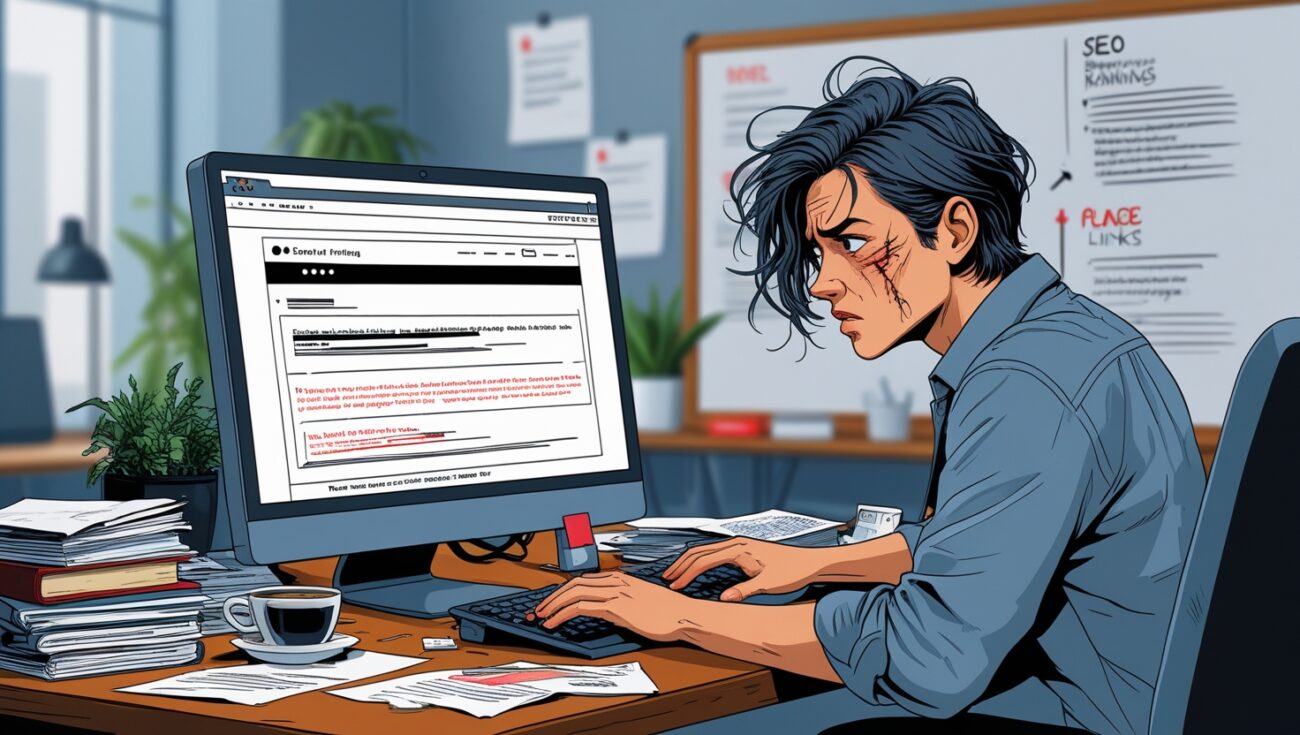Simple Internal Linking Mistakes That Are Costing You Rankings
Have you ever done all the “right things” for SEO—written amazing content, optimized your page titles, and created a user-friendly site—only to see your content languish on page 2 of Google? It’s a frustrating feeling, and it’s one I know well. For years, I was doing a lot of things right, but I was making simple, silent mistakes that were costing me my rankings.

Table of Contents
The most common mistakes I see, and the ones I used to make myself, are related to internal linking. They are so simple and seem so harmless that most people don’t even realize they are doing them. But these mistakes can have a huge negative impact on your SEO. Here are the most common internal linking mistakes I’ve found, along with simple, actionable fixes that can instantly improve your rankings.
Mistake #1: The Orphaned Page Epidemic
An orphaned page is a page on your website with no internal links pointing to it. It’s a page that is living on your site but is virtually invisible to search engines.
- The Problem: Google’s bots “crawl” your site by following links. If a page has no internal links, Google’s bots will have a very hard time finding it and, therefore, a very hard time ranking it. These pages don’t pass or receive any link equity and are a complete waste of your effort.
- The Solution: You need to conduct a site-wide audit to find these orphaned pages and link to them from relevant, authoritative content on your site. A tool can find all of your orphaned pages in minutes so you can start fixing them immediately.
Mistake #2: The “Click Here” Anchor Text
The anchor text of an internal link is one of the most powerful SEO signals you can give to Google. It tells Google exactly what the destination page is about.
- The Problem: Using generic anchor text like “click here,” “read more,” or “learn more” provides no context to Google or the user. You are wasting a huge opportunity to provide valuable information about the destination page.
- The Solution: Always use descriptive, keyword-rich anchor text that accurately describes the destination page. For example, instead of “click here,” use “how to fix internal linking mistakes.”
Mistake #3: Broken Links and Dead Ends
A broken internal link is a link on your website that points to a page that no longer exists.
- The Problem: They create a terrible user experience, and they also stop the flow of link equity dead in its tracks. It’s like a broken road on your website; it’s a dead end for both your users and Google’s bots.
- The Solution: You need to regularly audit your website for broken links and fix them immediately. When you find one, either fix the URL or, even better, redirect it to a new, relevant page on your site to recover that lost link equity. A tool can automatically find and alert you to broken links.
Mistake #4: The Link Hoarding Problem
This mistake happens when a single page has too many internal links on it.
- The Problem: Every page on your site has a certain amount of link equity to pass. When you have too many links on a single page, you dilute that link equity and make it less effective.
- The Solution: Be strategic with your internal linking. Only link to the most relevant, important pages from a given article. This ensures you are passing the maximum amount of link equity to the pages that matter most.
The Easiest Way to Stop Making These Mistakes
I know that a manual audit of your website for these mistakes is time-consuming and difficult. That’s why I’ve come to rely on internal linking automation. A good tool can take all the guesswork out of finding and fixing these mistakes for you, ensuring a perfect internal link profile. It’s the difference between spending hours on a tedious task and getting a list of high-impact opportunities in minutes. Ready to stop making these simple mistakes and start boosting your rankings? Discover how Linkbot can help you.
Conclusion: Take Control of Your Rankings
These simple internal linking mistakes are costing you rankings, but the good news is that they are all within your control to fix. By taking a few simple, actionable steps, you can start building a better, more powerful website and finally get the ranking results you deserve.
My journey taught me that a major mistake is seeing SEO as a mystery. By implementing a smart, corrective approach to my website, I made the mental shift from being a spectator to an active participant in my website’s success. This simple realization took the overwhelm out of SEO and turned it into a series of logical, manageable steps that I could control.
The long-term, compounding effect of fixing these mistakes is what makes it so powerful. Each time you add a thoughtful, relevant link, you are not just performing a task; you are building your website’s authority, one link at a time. These small, consistent improvements add up to a significant competitive advantage over the long term, making your website an increasingly powerful asset.
I can say from personal experience that there is a special kind of satisfaction that comes from seeing a direct correlation between a new link and a ranking boost. It’s the feeling of taking a tangled mess and organizing it into a clean, logical network. The result is a website that just feels better to navigate, for both users and the people managing it.
A clean internal link profile also has a huge impact on your website’s overall trustworthiness and authority. When a user or a search engine bot lands on your page and sees a clear network of interconnected, relevant articles, it signals that you are a serious, comprehensive resource on the topic. This kind of professional organization is exactly what Google looks for.
The most important part of this foundational skill is building a consistent habit of linking. It’s not about a single audit and then forgetting about it. A good website is a living thing, and it needs regular maintenance to ensure your internal links stay clean, which is a key part of long-term SEO success.
I felt like I was finally in the driver’s seat of my SEO. For years, I had relied on external factors, which felt like I was giving up control of my SEO destiny. But by mastering a simple task like building my internal links, I was proactively building my site’s authority from the inside out, on my own terms, which was an empowering and exciting feeling.
By implementing a strategy that serves both SEO and conversions, you are also directly addressing Google’s E-E-A-T framework. You are demonstrating expertise by creating topical clusters, you are showing authority by linking from strong pages, and you are providing a better user experience, which is a key part of what Google looks for in a trustworthy website.
I’ll never forget the first time I applied my new internal link strategy to a page that was struggling to rank, and it shot up in the search results almost overnight. This was my “aha” moment. I realized that a strategic, well-placed link from a high-authority page was far more powerful than I ever thought possible.
One of the greatest benefits I got from using an automated tool to manage my link profile was the “to-do” list it provided. Instead of being overwhelmed by the sheer size of my website, the tool gave me a prioritized, actionable list of fixes to make. It transformed a monumental, frustrating task into a series of manageable steps that I could tackle in just minutes.
It’s crucial to understand the difference between a simple, generic link and one that’s part of a strategic, mapped plan. A simple link is a one-off connection. A link that’s part of a plan is a purposeful part of a larger network, designed to pass authority and guide a user. The latter is far more powerful.
Ultimately, mastering internal linking is a simple but powerful strategy that transforms a website’s foundation. It’s a low-cost, high-impact fix that can instantly improve your site’s health and SEO performance. It’s the kind of foundational SEO work that every website owner should prioritize.
My final piece of advice is to not be intimidated. Don’t worry about the high cost of manual labor; just focus on making your website a better place for your readers. You will be amazed at the progress you make and the results you can achieve.

